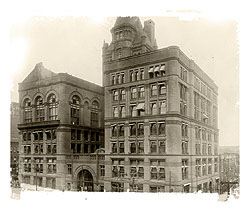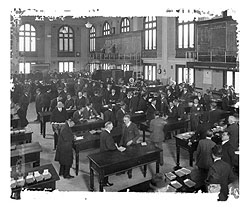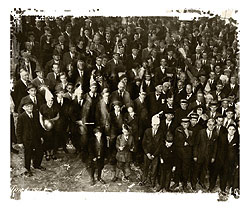Significant Dates in CFTC History — 1980s
Table Of Contents

KCBT Building, 1887 – 1924.
Photo provided by Kansas City Board of Trade

The last day in the old Board of Trade Building, January 1, 1925.
Photo provided by Kansas City Board of Trade

Trading Floor Board of Trade, Kansas City, January 9, 1925.
Photo provided by Kansas City Board of Trade
January 6, 1980—In an emergency action, the CFTC orders the suspension of futures trading for two days for wheat, corn, oats, soybean meal, and soybean oil on four exchanges after President Carter announces an embargo on the sale of certain agricultural goods to the Soviet Union that includes substantial amounts of grain.
January 21, 1980—COMEX orders trading for liquidation only in its silver futures contract.
September 8, 1981—The CFTC adopts a comprehensive set of regulations to govern exchange-trading of options on futures contracts under a controlled and monitored three-year pilot program.
September 22, 1981—The CFTC grants registration to the NFA as a self-regulatory futures association and approves its articles, bylaws, and rules. NFA begins to hire staff and commences operations on October 1, 1982.
December 7, 1981—The CFTC and the SEC jointly announce a basic jurisdictional agreement on the regulatory responsibility of each agency for a variety of financial instruments, in particular stock index futures. This agreement was known as the Shad-Johnson Accord and later became part of the CEA.
February 16, 1982—The CFTC approves the first futures contract based on a stock index, the Value Line Index Average traded on the KCBT.
January 11, 1983—President Reagan signs the Futures Trading Act of 1982, renewing the CFTC’s mandate to regulate futures trading for four more years and clarifying Commission jurisdiction in a number of areas. Among other things, this act codified the Shad-Johnson Accord (which gave the CFTC jurisdiction over broad-based stock index futures and banned single-stock and narrow-based stock index futures), and required the CFTC to act on new contract proposals and rule amendments within specified time periods.
August 29, 1984—The CFTC approves amendments to CME rules that allow it to establish a trading link with the Singapore International Monetary Exchange, the first trading and clearing link between a domestic and a foreign exchange.
September 28, 1984—The CFTC submits “A Study of the Nature, Extent and Effects of Futures Trading by Persons Possessing Material, Nonpublic Information” to its Congressional oversight committees.
February 28, 1985—The CFTC concludes its silver investigation, alleging that Nelson Bunker Hunt, William Herbert Hunt, and other individuals and firms manipulated and attempted to manipulate silver prices in 1979 and 1980.
March 20, 1985—Volume Investors, Inc., a clearing member at COMEX, defaults on a margin call on options on gold futures. The funds of 100 customers, mostly local traders, are affected by the default. This default causes the Commission to consider numerous changes to its rules. Ultimately, improved surveillance, early warning, and margining procedures are developed.
September 23, 1986—CFTC, SEC, and the U.K. Department of Trade and Industry announce the signing of an MOU, which will enhance cooperation and mutual assistance in securing compliance with and enforcement of securities and commodities laws in both countries.
October 19, 1987—Biggest one-day price plunge in stock market history. No Commission-regulated systems fail, no firms default on obligations.
May 16, 1988—The President’s Working Group (PWG) on Financial Markets, composed of CFTC, SEC, Treasury, and the Federal Reserve Board, presents its report on the October 1987 stock market break to President Reagan.
October 18, 1988—The CFTC approves proposals to amend daily price limits and trading halt provisions for stock index futures and option contracts traded on CME, CBOT, KCBT, and NYFE. These proposals were based on recommendations by the PWG.
January 20, 1989—The news media report the disclosure of a two-year undercover investigation of the Chicago trading pits conducted by the FBI in cooperation with CFTC and DOJ. The CFTC takes a number of market integrity actions in the following months.
February 2, 1989—The CFTC unanimously approves rules proposed by CME for the basic Globex system, the first international electronic trading system. Trading begins in June 1992.
July 11, 1989—The CBOT institutes an emergency action concerning the July 1989 CBOT soybean futures contract. CBOT requires all large traders to reduce their positions prior to the expiration of the July contract. The contract expires in an orderly manner.
| FY 1980 |
FY 1981 |
FY 1982 |
FY 1983 |
FY 1984 |
FY 1985 |
FY 1986 |
FY 1987 |
FY 1988 |
FY 1989 |
|
|---|---|---|---|---|---|---|---|---|---|---|
| Actual FTE | 465 | 485 | 484 | 493 | 500 | 520 | 489 | 497 | 510 | 535 |
| Approved Appropriation | $16 | $18 | $20 | $23 | $26 | $27 | $28 | $30 | $33 | $35 |



